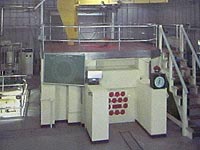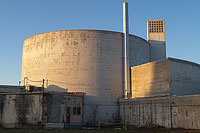Reactors Designed by Argonne National Laboratory
BOOKSHELF
 “Plentiful
Energy: The Story of the Integral Fast Reactor” by Charles E. Till and Yoon
Chang gives the history of the IFR at
Argonne. The book is available on Amazon.com.
“Plentiful
Energy: The Story of the Integral Fast Reactor” by Charles E. Till and Yoon
Chang gives the history of the IFR at
Argonne. The book is available on Amazon.com.
More about the book »
More about the IFR »
Training Reactors
Reactors designed and operated by Argonne as a resource for training students and/or technicians.
Back to Argonne Reactors Overview
Argonaut
When applied to nuclear reactors, the term “Argonaut” refers to a class of small nuclear research and training reactors and is actually an acronym for ARGOnne Nuclear Assembly for University Training. The Argonaut design was developed by Argonne, and the original Argonaut reactor was built at Argonne for about $100,000 and went critical for the first time on February 9, 1957. This 10-kW water cooled and moderated reactor was built to teach reactor theory and nuclear physics to university students and operated at Argonne until 1972, when it was shutdown, dismantled, and shipped to Taiwan to continue its mission of training students. Students from over 40 countries who attended Argonne's International School of Nuclear Science and Engineering were trained on the reactor during its tenure at Argonne.
For the second International Conference on the Peaceful Uses of Atomic Energy, held in Geneva, Switzerland September 1-13, 1958, the U.S. Atomic Energy Commission asked Argonne to provide an exhibit that would eclipse the impact of the exhibit at the conference by the Soviet Union, which was showcasing its two Sputnik satellites that had been launched almost a year earlier. Argonne responded by building a second Argonaut reactor, then dismantling and transporting it to Geneva, and reassembling it during the first four days of the conference, giving conference attendees an opportunity to see how the reactor was put together. On the sixth day of the conference, Argonne staff brought the reactor to criticality, using some of the uranium from the CP-1 reactor. During the final days of the conference, the reactor was dismantled and then shipped back to Argonne. Some parts were reused in the Juggernaut reactor.
Using Argonne’s design, many Argonaut class reactors of various powers have been built and used throughout the world as training reactors. About ten were built and operated at nuclear engineering departments at universities in the United States.
Want to know more about the International School and the role the Argonaut played in it? Visit Argonne's page on education history at the lab: Education: The Effort Is Global.
CP-5 (Chicago Pile 5 Reactor)
Although not primarily a training reactor, the CP-5 heavy water reactor played an essential role in training of technicians working in nuclear power plants. This was the prime support reactor for Eisenhower's Atoms for Peace program, the International School of Nuclear Science and Engineering.
For more information on CP-5:
Heavy Water and Graphite
Reactors: CP-5 Reactor
Related Information
- About Nuclear Energy
- Argonne’s Nuclear Energy Exhibition Hall highlights our pioneering role in developing peaceful uses of nuclear technology used by major nuclear power plants throughout the world. For more information, call (630) 252-5562 or email [email protected].
- Argonne OutLoud Lecture: How Advanced Reactors will Change Nuclear Power and the World (May 11, 2017)
- History of Argonne Reactor Operations [2.2MB]
- Nuclear Energy FAQs (Frequently Asked Questions) [[an error occurred while processing this directive]B]
- NOVA episode: The Nuclear Option: How will we power the planet without wrecking the climate? Aired January 11, 2017 on PBS
Last Modified: Tue, September 17, 2019 10:48 AM



